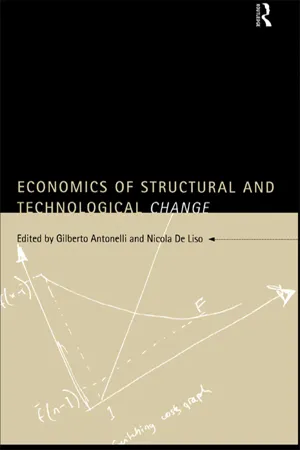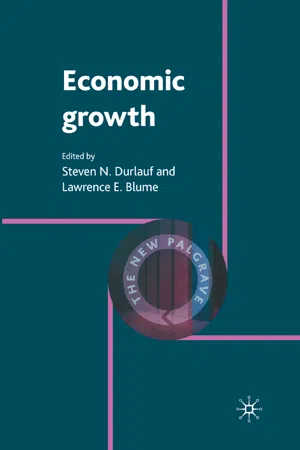Economics
Technological Change
Technological change refers to the process by which new technologies are developed and adopted, leading to improvements in production processes, products, and services. It encompasses the invention, innovation, and diffusion of technology, and has a significant impact on economic growth, productivity, and competitiveness. Technological change can also disrupt existing industries and create new opportunities for economic development.
Written by Perlego with AI-assistance
Related key terms
1 of 5
8 Key excerpts on "Technological Change"
- Alan Milward, S. B. Saul(Authors)
- 2013(Publication Date)
- Routledge(Publisher)
Chapter 3Technological Change
The Theory of Technological Change The Transfer of Technology The Development of Technology -Coal -Textiles - Iron and Steel - Engineering - Power Engineering - Shipbuilding - Chemicals 226 - Agriculture 233 Conclusion 244 Suggested Reading 246There is little doubt that Technological Change has been a major force in promoting economic growth over the last two centuries. Just how important is a matter for debate. Some economists have argued that it has been far more significant than simply the increased employment of capital and labour. Evidence is mounting to suggest that this is an exaggerated view and that we ought to maintain the emphasis that earlier analysts gave to variables such as the ratio of savings to national income. But however that may be, technology has clearly played a most important role in many aspects of growth — not just in raising incomes but in changing the location and size of industry, in altering the role of different raw materials, in changing social patterns of work, in altering for good and ill the quality of life itself. As for capital we must, at least, stress the importance of determining the amount of technological advance incorporated when any investment is made. Technology embraces in these contexts a wide range of activities. It may mean a new process of manufacture or a new final product. In some circumstances it can better be described as ‘know-how’ — the ability to organise and operate plant within the existing range of technological knowledge. It involves all those supplementary benefits accruing from the expansion of centres of industrial activities known as external economies. It includes the economies reaped from increases in the scale of activity and the greater efficiency derived from the process of learning a job by doing it again and again. It relates, too, to the quality of the workforce at all levels.- eBook - ePub
- Jay Mitra(Author)
- 2017(Publication Date)
- SAGE Publications Ltd(Publisher)
1 An Introduction to Technological Change and InnovationScope and Objectives
- An introduction to the meaning and significance of Technological Change for innovation, growth, economic and social development.
- A focus on developed economies where Technological Change has been most pronounced in the last two centuries.
- Critical appreciation of underpinning economic theories that help to explain the relationship among Technological Change, the knowledge production function, exogenous and endogenous growth, spillover effects, innovation and economic growth.
- An understanding of the contexts of Technological Change and the significance of organisational and social change generated by advances in technology and innovation.
Introduction
The connection between innovation, entrepreneurship and technical change is predicated upon the idea that their mutual interdependence leads to improved economic performance at the level of the firm, the industry, the region and the nation. Changes in technology and their use enable the creation of new products and services. The mobilisation of resources through the formation or growth of firms characterises the entrepreneurial process which brings these new products and services to the market. With the gradual diffusion of these innovations, incumbent technologies and businesses give way to new and more productive counterparts. Firms enjoy higher levels of productivity, consumers take advantage of either cheaper or better value products and services for which they may be willing to pay more, new jobs are created, we obtain a better quality of goods and services, and the gross domestic productivity of the nation increases over time. Technical advance prompts the creation of new products and services, the formation of new firms, and economic growth.Economies grow because of numerous factors that enable growth to occur. Increases in market size enable increases in gains from trade, resulting from the division of labour and competitive resource pools. Investment in physical and human capital causes economic growth. Another key source is Technological Change (Lipsey et al., 2005). Understanding how the growth process is linked to technical change, innovation and entrepreneurship is vital for any business and policy makers. Understanding the drivers and effects of innovation and entrepreneurship is critically important because we are all conscious of the fact that technical change is related to improvements in performance at the level of the individual business, the industrial sector in which the firms are located, and at the regional and national levels (Link and Siegel, 2007). - eBook - ePub
- Cristiano Antonelli, Nicola De Liso(Authors)
- 2002(Publication Date)
- Routledge(Publisher)
1Introduction: An appraisal of the economic analysis of Technological ChangeThe path to the last decade
Gilberto Antonelli and Nicola De Lisa1
1 Technological Change AND POLICY-MAKING
1.1 The relevance of Technological Change: a background to policy debate
Technological Change has undoubtedly been one of the most important features of the economic history of the world at least since the occurrence of the first Industrial Revolution in the last quarter of the eighteenth century in England. Since then, technical change has shaped the development of economies through the continuous occurrence of both major and minor changes.Technical change affects many aspects of both economic and social activity. It influences production in qualitative and quantitative ways, and affects employment, international trade, investment and consumption patterns. These widespread effects of technical change are such as to warrant the examination of the interaction of technical change, market forms and overall economic structure.Given the quantitative and qualitative importance of Technological Change, it is easy to understand why during the last thirty years there has been an escalation of studies concerned with it. Techniques of production now last for shorter periods; changes, however small, follow one another, and the need to capture the essence of the processes connected with Technological Change is felt more and more urgently. Both theoretical and empirical developments in the 1980s represented a turning point for economic analysis.It seems to us that these comments highlight fairly well the fact that any analysis of Technological Change is influenced by policy implications, which, as such, induce action shaped by political interests and values. Many questions can arise here.The first we consider, given its social relevance and capability of shedding light on the chains activated by policies, is unemployment. The early 1990s have been characterized by a general concern as structural long-term unemployment seems to persist and increase, and when signs of growth are visible we speak of jobless recovery. There thus emerges the question: what is the socially tolerable level of unemployment? Should governments intervene, and, if they should, how? The main alternatives in the policy arena are the following: (a) short-term flexibility as a cure mainly of labour market rigidities; (b) investment demand expansion combined with fiscal policy revitalization; (c) stimulation of new market opportunities and product innovation; (d) international competitiveness and strategic trade; (e) long-term flexibility based on the development of individual, social and technological capabilities. However, each of these solutions has a draw-back, taking also into account the composite nature of unemployment: from the effectiveness of the policy prescription to the need of increasing taxation, the risk of increasing inflation, and so on. These last points make it clear that whenever policy action is undertaken there occurs a series of reactions in the economic system, not all of which are desirable. And economic analysis should be engaged in increasing the degree of awareness of this, showing the likely scenarios in which complementarities and feedbacks share the same importance as clear-cut alternatives. - eBook - PDF
- Adam Szirmai(Author)
- 2015(Publication Date)
- Cambridge University Press(Publisher)
In this sense, Technological Change is a driving force in development and has been so since the dawn of humanity (see Boserup, 1981 ; Lapperre, 1992 ). At the same time it is misleading to see technology as an exogenous force. The term ‘ driving force ’ suggests technological determinism: technology comes from outside and drives us inexorably in certain directions. Though consistent with the ways in which most people experience Technological Change, this perspective is incorrect. Technological Change is the result of focused human efforts in research laboratories, scienti fi c institutes, small and large fi rms, or inventors ’ backyards. Societies, organisations and individuals invest in knowledge, schooling and research, just as they invest in physical capital goods. Thus, Technological Change is driven by human actions and choices. It is not an external phenom-enon, which develops in complete autonomy. Whenever we say that Technological Change is uncontrollable and inevitable, this is just another way of saying that many outcomes of human actions and choices in general are relatively autonomous and hard to control. Technological Change is no different from other spheres of human behaviour. The process by which technological advance is achieved is referred to as innovation. Following The Oxford Handbook of Innovation (Fagerberg, Mowery and Nelson, 2005 ), the concept of innovation refers to the putting into practice of inventions. This involves developing an invention or idea into something that is commercialised and creates economic value. One can distinguish between a narrow concept of innovation focusing on strictly technological innovations in new products or new methods of production. But in the Schumpeterian tradition (Schumpeter, 2000 , see section 3.2.7 of this book) there is also a broader notion of innovation including the development of new types of organisation and the discovery of new marketing techniques, new markets, or new sources of raw materials. - eBook - PDF
- Steven Durlauf, L. Blume, Steven Durlauf, L. Blume(Authors)
- 2016(Publication Date)
- Palgrave Macmillan(Publisher)
technical change The successive transformations of economic society since the 14th century from agricultural to industrial form and beyond to the service economy have consolidated a process of economic change with its own inner logic of tremendous power, a logic which harnessed continual technical and organizational innovation to the pursuit of profit. At the core of the new logic is the intertwining of emergent knowledge and economic adaptation to its hidden possibilities that has been the basis for the sustained increase of aggregate output per person employed – the chief proximate source of increased standards of living in the Western world – the progressive mechanization and automation of production methods, and the continuous development of the economic structure (Kuznets, 1977; Mokyr, 1990; 2002). The gains in material welfare, in length of human life, in life experience and functioning have been beyond anything achieved before the 18th century, yet knowledge-driven progress comes at a price. It is necessarily uneven in its incidence across space and time, and the ensuing disparities of performance can and do impose heavy human adjustment costs as old ways give ground to the new. Skills are devalued, capital assets lose the capacity to generate income, while there is little prospect of the losers receiving compensation. If the balance sheet speaks to progress, it does so in a tangled way. This is the ethic of competition, and nowhere is this unevenness more apparent than in the seemingly unavoidable differences in economic performance between advanced and developing countries. Knowledge-driven economic growth is never a smooth, balanced affair of proportional expansion with each activity advancing in step. Rather, as Schumpeter insisted, it involves disharmony and fierce competition between new and old activities and places, a diversity of growth rates and profit rates and continual reallocation of labour and capital between and within activities. - Valpy FitzGerald, Judith Heyer, R. Thorp(Authors)
- 2011(Publication Date)
- Palgrave Macmillan(Publisher)
Part II Technical Change and Economic Development 3 Technology Change: Sources and Impediments Gustav Ranis, Mallory Irons and Yanjing Huang 3.1 Introduction The relationship between technology change and economic growth has been of interest to economists for centuries, but especially since Robert Solow made his seminal contribution to the neoclassical model of eco- nomic growth in the 1950s, which has led to an explosion in the follow-up literature. Interest in technology change waned perceptibly in the 1980s. However, with the arrival of the ‘new growth theory’, a notable revival of focus on the subject can be observed. Overall, there remains little doubt that there is a consensus that technology change, in terms of both its process and its quality dimensions, represents the prin- cipal driving force in explaining comparative economic performance at the micro- and macro-levels. That said, exactly how technology change is generated and what impedes it remains less clear. The standard neoclassical approach assumes the rate of Technological Change to be exogenously determined. Solow’s model predicts that rich and poor countries alike will, in the long term, converge to steady rates of growth that are determined by technological progress, the savings rate and the growth of the labour force. While the model confirms that higher savings rates lead to higher rates of growth, capital accumula- tion takes a back seat to Technological Change (Solow, 1956). This is not to deny that investment is likely to be required to ‘carry’ technology change. The ‘new growth theory’ attempts to render technology change endogenous and, by asserting that externalities permit the mainte- nance of sustained growth in spite of an increase in the rate of 45 46 Technical Change and Economic Development investment, 1 thus avoids the diminishing returns to investment issue that troubled the Solow model.- eBook - PDF
Technological Change In Agriculture
Locking in to Genetic Uniformity
- D. Hogg(Author)
- 2000(Publication Date)
- Palgrave Macmillan(Publisher)
3 The Determinants of the Path of Technological Change in Agriculture: An Unorthodox View Introduction This chapter seeks a closer understanding of how various influences are brought to bear in the development, by formal agricultural research, of new techniques and technologies in agriculture. In particular, it sheds light on why some technologies are chosen rather than others. An explanation is offered for the possibility of becoming locked-in to a particular way of doing agriculture. In so doing, an evolutionary metaphor is employed, from which perspective, different influences act as sources of selection pressure. These lead to the adoption of a path followed by research which determines which technologies may emerge from what are presumably myriad possibilities. First, the conceptual basis for this view is elaborated. Following this, using concepts of lock-in (to a particular technological trajectory) and lock-out (of alternatives), it is suggested that research tends to follow trajectories of innovation based around a fairly stable, though none- theless evolving, techno-economic mode. Chapter 4 builds on this synthesis. Evolutionary economics and the study of technical change Schumpeter and the revival in evolutionary economics Evolutionary perspectives in economics are very much in fashion. Evolutionary thinking in economics is nothing new, and has a notable pedigree. 1 Renewed interest reflects the belief that the keystones of economic orthodoxy, its assumptions concerning the rationality of actors and preoccupation with equilibrium, are losing their capacity to support the edifice founded upon them. Dismissing disequilibria as 74 temporary aberrations in a world of economic equilibrium, has become increasingly untenable in a world defined by, as Giddens puts it (though he specifies the capitalist world), ‘chronic economic mutation and technological innovation’ (1979, 223). Yet concern with change need not necessarily imply an evolutionary perspective. - eBook - PDF
- Gregory Tassey(Author)
- 1997(Publication Date)
- Praeger(Publisher)
As a result, estimates of the contribution of Technological Change to economic growth have varied significantly. One reason for the variance in economists' estimates is that some studies incorporate quality adjustments in the measurement of the quantities of inputs. 3 How adjustments for quality changes are made greatly affects estimates of the impact on growth rates from Technological Change. In reviewing the economics literature on macroeconomic estimates of the contribution of Technological Change, Boskin and Lau [1992, p. 31] found that "on average, the proportion of economic growth explained by technical progress, with quality adjustment of the inputs, is 25 percent. This proportion increases to 52 percent in the 3 An example of a input quality adjustment would be an increase in the purity of silicon used to make the wafer from which semiconductor components are manufactured. 40 The Economics of R&D Policy absence of quality adjustments of the inputs. In other words, when changes in the quality of inputs are attributed to technical progress, the estimated contribution of technical progress is on average doubled." However, the macroeconomic studies that make adjustments for quality do not identify the origin of these improvements. In this situation, because much of observed quality improvement in the economy has a technical origin, it seems reasonable to conclude that the economic impacts of these improve- ments belong in the "residual" just as much as other forms of technical progress. Under this assumption, the 52 percent average estimated contribution of technology to economic growth is viewed as closer to reality. Boskin and Lau [1992, p. 47], using an improved form of the restrictive conventional production function (called the meta-production function), confirmed the findings of earlier studies.
Index pages curate the most relevant extracts from our library of academic textbooks. They’ve been created using an in-house natural language model (NLM), each adding context and meaning to key research topics.







